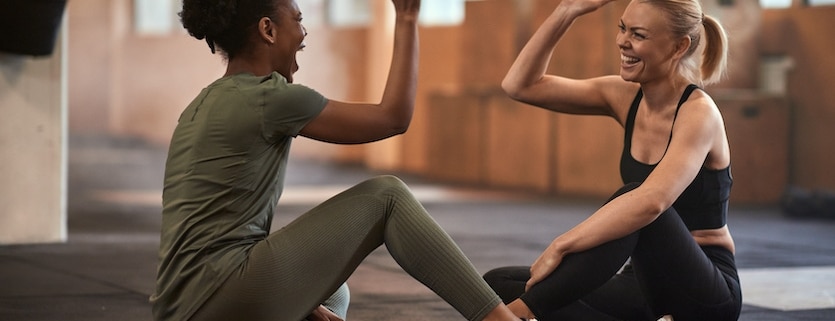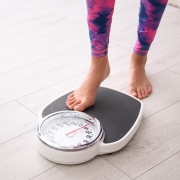Getting Back in Shape

80% of North Americans don’t exercise enough each day, and it’s a growing problem in other continents as well. The recommended amount of exercise is about 20 minutes per day. When you exercise regularly, you may experience these health benefits:
- Helps in weight management
- Supports cardiovascular health
- Helps the body manage blood sugar levels
- Supports mental health and mood
- Strengthens bones and muscles
- Improves the quality of sleep
- Increases longevity
For all these reasons and more, many of us try to integrate exercise into our daily lifestyle. But it’s not easy to prioritize your health when life becomes hectic. Maybe it was an injury, a job change, a new baby, or something else that forced your workout routine to take a backseat. We’ve all been there. But if you’re reading this article, then you’ve probably been thinking about the best way to start again.
The good news is that there are many ways to get back in shape.
Workout Motivation Tips
Before you start, it’s important to think about why you fell out of the routine in the first place. Was it a lack of motivation? Were you setting the right goals? These are things you can control, even if your life is busy.
Some people make the mistake of setting the intensity of workouts way too high in the beginning. This can hurt motivation in the long run and make it difficult to maintain consistency. If that sounds like you, consider making your workouts lighter and fun in the beginning. Others might be motivated by more intensity (if it’s applied to the right training techniques) because it may produce results sooner.
Fitness accessories can be a motivating factor also. Rewarding yourself with a new pair of Bluetooth earbuds or gym shoes could make it easier to continue your workout routine when the initial excitement has worn off.
Whatever your needs and goals are, it’s important to design a program that works for you. It’s also a good idea to consult with your primary care physician before starting a new exercise program.
Now let’s take a closer look at a couple different approaches to getting back in shape.
Back to the Basics: Simple Workouts
Easing your way back to your fittest self is the best approach for most people that have been sedentary for a while. Especially if you’re coming off an injury or just had a baby. Or maybe you’re getting back in shape at 50 years old. There are many reasons why a safe, slow-paced return to fitness would be your priority.
Walking around your neighborhood is one of the easiest ways to start moving your body safely. You can walk for 10 minutes or less each day at first, and ultimately shoot for 20–30-minute brisk walks daily.
You can also try to do more active tasks at home throughout the day. This concept has been called High-Intensity Incidental Physical Activity (HIIPA). It includes any daily task that can be done at a high enough intensity to raise the heart and breathing rate.
Taking the stairs, carrying groceries, washing a car, or gardening are just a few examples of HIIPA. If you can find tasks that are above your current activity level, adding them to your routine is an easy way to improve your fitness.
Once you’re moving easier, adding bodyweight exercises like squats, lunges, pushups, and crunches is a great next step. These can all be done at home without any equipment.
You’ll want to add in some short bursts of cardio too. Jumping jacks and burpees are great options for cardio at home. You can even try linking these different exercises into a back-to-back circuit to get your heart rate up. A circuit workout might look something like this:
- 15 Squat Jumps – Start with your feet shoulder width apart. Bend your knees and lower into a squat position. Jump straight up and return to the squat position.
- 15 Push-ups – Position yourself down on all fours. Then straighten your arms and legs. Lower your body until your chest nearly touches the floor, then push yourself back up.
- 15 Burpees – Stand with your feet shoulder width apart. Lower into a squat position, and then the push up position by kicking your feet back and placing your hands on the ground. Jump up and return to the standing position.
- 1 min Plank – Get down on all fours. Straighten your arms and legs. Hold the position.
- 1 min Wall sit – Lower yourself into a squat position with your back against a wall. Hold the position.
Rest about 20 seconds in between each exercise and repeat the circuit 2-3 times.
With daily walking, bodyweight training and short bursts of cardio, you’ll easily hit 20 minutes of exercise a day. But you might want to elevate your workout routine after a few weeks.
Intermediate Training Tips
This would be a good time to start an endurance sport like running. Look up a 5k or 10k race in your city and sign up! You could also sign up for a local soccer club or join a hiking group. There are many ways to switch things up and increase your endurance.
If you want to try strength-training for the first time, find a gym and consider working with a certified personal trainer in the beginning. They’ll help you learn the correct form for various exercises. If you do have strength-training experience, remember these tips when starting again:
- Always warm up with about 5 minutes of aerobic activity
- Compound exercises like squats, deadlifts, and pull-ups are the most important
- In the first few weeks do 2-3 sets of 10-12 repetitions with a weight that feels relatively light, until you’ve perfected your form
- Limit your workouts to just a few compound exercises in the beginning
- Use a spotter when performing free-weight exercises
As you gain strength and experience you can add accessory exercises that isolate different muscles. You can also begin increasing the weight that you’re lifting. As you gain strength, you’ll perform less repetitions of heavier weight.
How to Get in Shape Fast
Has anyone ever told you there are no shortcuts to success? That’s not entirely true in fitness. High Intensity Interval Training (HIIT) has been shown to get you in shape faster than other training methods.
The basic idea is that you’re “sprinting” or going as fast as you can for a short period of time followed by a period of rest or easy movement. Then you repeat this cycle 4-6 times.
HIIT may sound intimidating, but there’s room for quite a bit of variation in intensity. It can also be done with any kind of aerobic exercise. Running, stair climbing, rowing—you name it.
Let’s say you’re a cyclist training on a spin bike. Your HIIT session could start with 30 seconds of all-out pedaling, followed by slow pedaling for one minute. Repeated 5 times. Incorporating HIIT into your training can seriously improve your fitness in just a few minutes.
Benefits of HIIT:
- Burns a significant amount of calories
- Increases metabolic rate
- Improves oxygen consumption
- Improves aerobic and anaerobic performance
- Produces similar benefits as 2x the amount of moderate exercise
While HIIT training is largely focused on aerobic conditioning. There are also ways to use it in weightlifting. Choose compound movements, shorten your rest time, and incorporate some cardio bursts to combine HIIT and strength.
It’s Never Too Late to Get Back in Shape
You gain all sorts of physiological benefits from exercise—that much is clear. But there are also changes on a genetic level. Over 3,000 genes are expressed differently in the muscles of people that exercise compared to sedentary muscles. A study published in PLOS Genetics measured the impact of training on these genetic changes.
The researchers trained one leg of each study participant, using a leg extension machine for three months. The other leg remained untrained. Then the participants took a 9 month break from training. When they resumed training, both legs were trained equally, and final biopsies were taken.
The results showed that the leg that had been trained 9 months earlier looked virtually the same as the newly trained leg.
The authors analyzed the results a couple different ways. It’s clear exercise spurs healthy genetic changes, and you must exercise consistently to sustain those benefits. But they also suggest that sedentary people stand to gain the same benefits from exercise as anyone that’s already been training consistently.
Whether you’ve been out of the gym for six months or ten years, it’s never too late to get back in shape and build consistent healthy habits!












